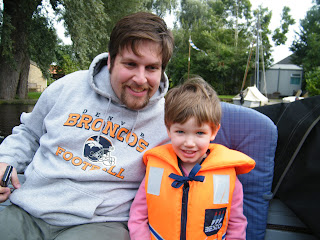After leaving Almelo, we took a weekend detour through
Friesland before going back to work on Monday. Yes, for those of my readers who
know the word friesian, I do mean that Friesland. For those who don't,
Friesland is one of the northern most provinces of the Netherlands.
It has a unique personality because it's the one Dutch
province that the Romans didn't conquer when Julius Caesar came up the Rhine in
whatever year B.C.E. Friesland is also
the province that has been most reclaimed from the sea. Canals are more popular
than roads, boats and bikes than cars, and every house and field backs up to a
waterway.
 |
| Pulling up to Kees and Rie's backyard. This once was the location of a WWII farmhouse. Then it became a thriving boat building business. There is a road out front, but the canal out back is bigger. |
The Friesian people are proud of their differences and very
proud to be Friesian. The average
Dutchman is inclined to roll his eyes if you mention Friesland to him because
they've all had a taste of Friesian pride, and they're none of them inclined to
think it warranted. Still, after seeing
a glimpse of Friesland, I have to think that the Friesians are uniquely
privileged to live where they do and uniquely gifted to have pulled it
off.
 |
| Those "triangular white things" as seen from far off. |
We spent the weekend with Kees and Rie, Seth's
great-uncle and aunt. Specifically, Rie
is Beppe's younger sister. In their
younger days, Kees and Rie operated De
Horse Watersports, a homebuilt boat building and rental operation. Nowadays, they purse their various hobbies
(Kees -- the stockmarket and philosophy, Rie -- quilting and gardening), dote
on their grandchildren, and show American relatives the special places of their
Friesian roots.
 |
| Uncle Kees ("Case") and Aunt Rie ("Ree") catching me in the act of snapping their picture. |
 |
| The church in Toppenhuizen. |
The afternoon that we got there, Rie took us to see
the old churches of Toppenhuizen and Oppenhuizen where generations of Atsmas
and Wijnijas are buried (I looked for Roordas or Beibors but in vain. I did, however, find a lot of names I knew of
no relation. Look for them in a later
post.) . These churches have all the old
accoutrements: wooden benches, raised Scripture podiums, liturgical drapings,
and Christ candles, but they are in no way out of date. The fellowship hall in Oppenhuizen has a
computer on wheels and was preparing for a gathering with a sister congregation
from (Eastern) Germany, and as Rie told us, they have a female minister. Still, the churches are old and in the
process of being restored as historical objects. The Toppenhuizen church was built in 1695, a
time when Dutch Reformed Christianity was not yet a settled business.
 |
| Boogaloo finds her favorite animal on the foot of the preaching podium. |
 |
| The organ in the church at Oppenhuizen. Seth has a fondness for large organs. |
 |
| Rie was surprised that the CRC churches in the States no longer use the liturgical drapings or podiums. |
The next day, Kees and Rie took us out on one of
Kees's boats. Being a boat builder, he
has two operational boats and a couple of others lying around. Just behind his house is the harbor that he built on land that he purchased from the government. The number of boats in it testify to the necessity of water transportation around here.
 |
| A view of the canals heading under the main highway. |
The canals themselves are much bigger than I
expected. I was expecting something
about ten feet across, something akin to the irrigation canals I had known
growing up in the Yakima Valley or the waterways I had seen in Eindhoven. No, the canals in Friesland are like major
rivers. They support industrial shipping
and major transportation. You'd never
know that they are a manmade feature to look at them because they bend and
curve just like rivers, and the edges are rough and natural, largely unmarked
and seemingly unfortified.

Water in Friesland is an acknowledged part of daily life. Children learn to operate boats from the age of six or seven, and the water has its own edicate. At the revolving bridges, boaters have the right of way, and road traffic waits for the boats to pass by. In some places, the road has died away, but the bridge still stands open on the canal, like an disused railroad crossing or a superwhammadine lawn ornament.
 |
| A Friesian youngster operates his or her first solo boat. |
 |
| A disused rotating bridge from a road that no longer exists. Notice that the bridge is still painted. Friesians keep their backyards neat. |
 |
| What you are looking at, behind my husband, is a dike. Behind that, where the cows are, is a polder. |
I spent the
first fifteen minutes of the boat ride looking for a glimpse of the famous
dikes and polders before I realized that the dikes are that slight swell of
land on the edge of the field and the polders are everything in between. As
Seth commented, it can really give you a turn to realize that the land on the
inside of the dike is about six inches lower than the water on the outside
because when you're out here, you realize that the dikes don't enclose the
water. They enclose the land and keep
the water out.
 |
| The water is beautiful, but after an hour on the canals, Boo decided she was ready to be back on land. |

No comments:
Post a Comment